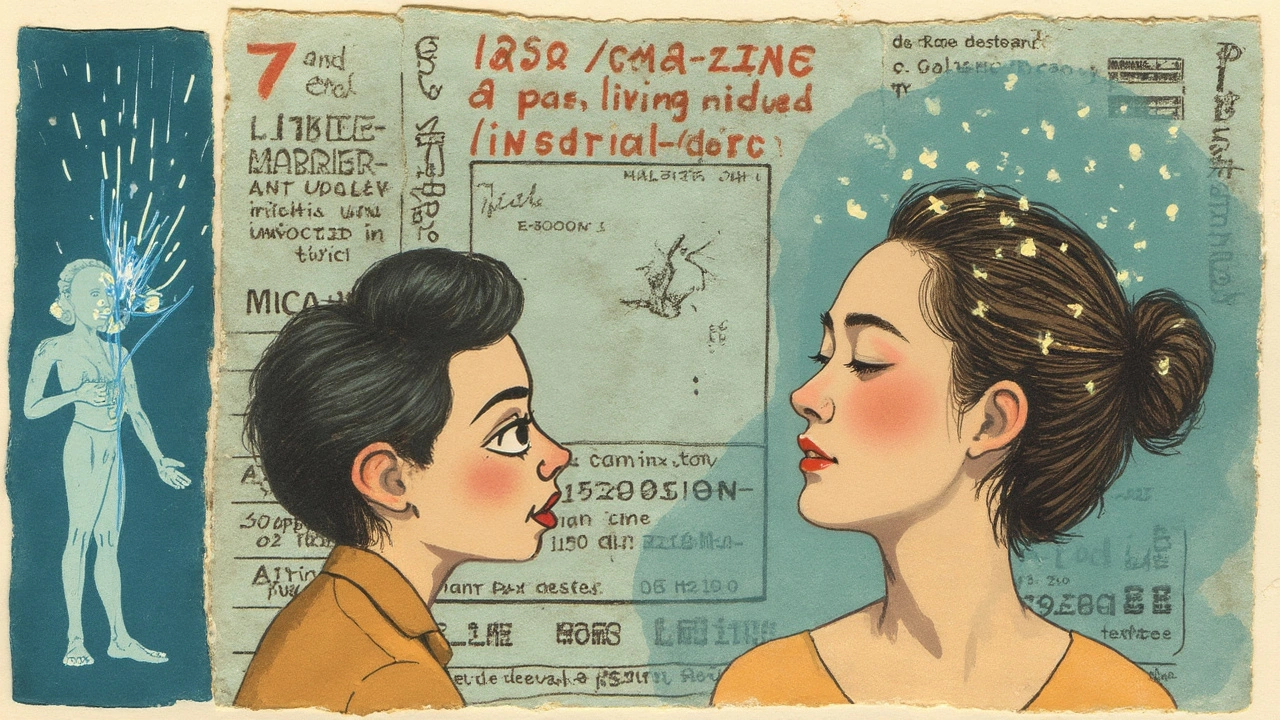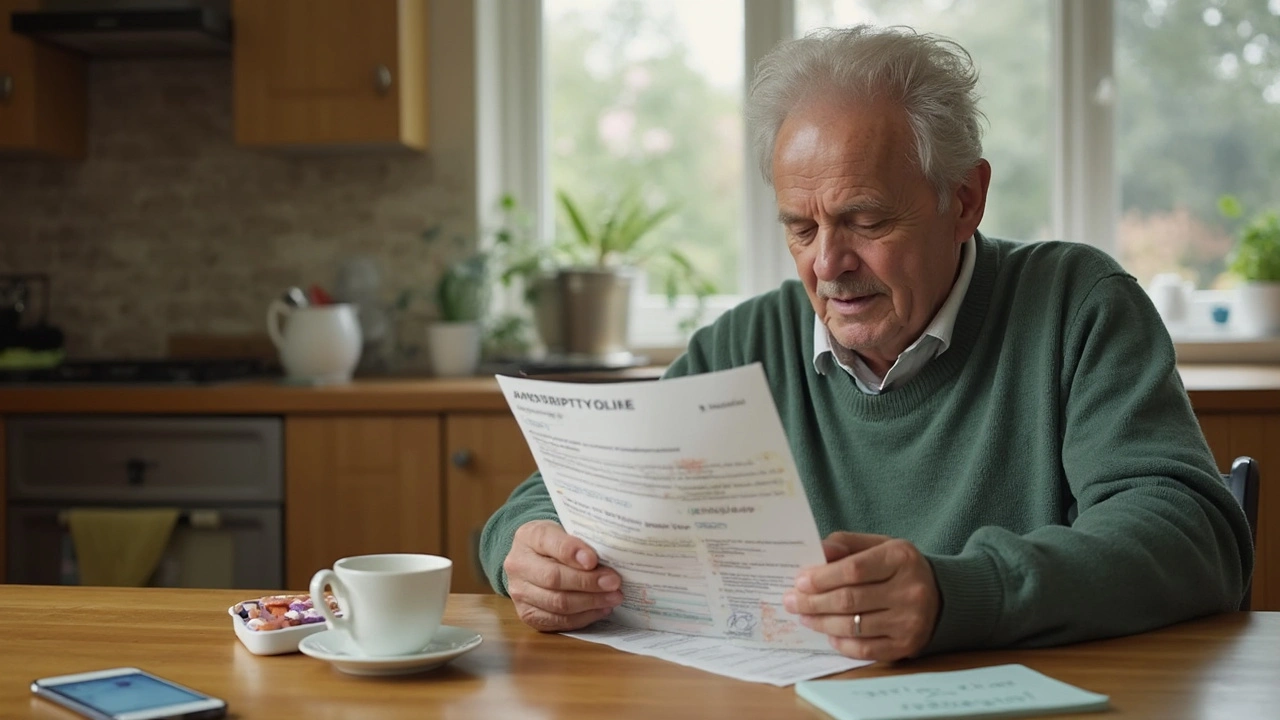If you lined up antidepressants by age, amitriptyline would look like the wise older sibling with a few wrinkles but plenty of stories. It’s been treating more than just low moods since the swinging '60s. It handles a surprisingly long list of issues, from nerve pain to migraines, insomnia, and even IBS. At the same time, stories float around about zombie-like drowsiness, mouth as dry as sand, or some random old-school side effects. Even so, it keeps popping up in pharmacy bags across the world.
How Amitriptyline Actually Works in Your Body
Take a look inside your brain after popping an amitriptyline—obviously, not literally. What happens? Amitriptyline is a tricyclic antidepressant, meaning it’s built from three-ring structures, a detail that somehow lets it mess with your brain’s chemical messengers. Imagine serotonin and norepinephrine as delivery drivers for good vibes and calm nerves. Amitriptyline doesn’t let these messengers disappear too fast. It acts like an overzealous security guard, blocking their exit doors (the reuptake pumps) so they hang around in your brain's synapses much longer.
This extra hang-time is believed to help balance mood, ease nerve pain, and help people sleep. Some scientists think it also tames overactive pain signals fired off in conditions like fibromyalgia and chronic tension headaches. Here’s something wild: Amitriptyline sometimes gets used in sleep clinics not for depression, but specifically to help people knock out faster and deeper, because of its heavy drowsiness kick. And it’s not just a minor effect—one study from 2022 reported that about 60% of people on amitriptyline for chronic pain also noticed their sleep improved dramatically within the first two weeks.
But you don’t get all these perks without a cost. Amitriptyline’s old chemistry means it isn’t picky; it loves to block all kinds of receptors in your body, especially acetylcholine. So, if you feel like you need to guzzle water, squint at tiny print, or move at half speed, those are the not-so-cool anticholinergic effects. But more on that in the chapters below.
Main Uses of Amitriptyline (Spoiler: It’s Not Just Depression)
The word “antidepressant” almost feels like a lazy label here. Amitriptyline may have been cooked up for depression, but doctors now throw it at a mix of problems. Got neuropathic pain that burns for no clear reason? That’s one of its specialties these days. If you’ve ever had shingles pain that wouldn’t quit, your doctor probably at least considered this drug. Then you have people who have tried modern, fancier antidepressants and found that nothing quite hit the spot—turns out, some folks still respond best to amitriptyline.
Migraines? Absolutely in the toolkit. Experts use it to prevent attacks in people who’ve already tested out other meds or can’t take more popular, newer drugs. IBS (Irritable Bowel Syndrome) might sound random, but research shows tiny doses can mellow the brain-gut communication chaos that causes the cramps and pain. Even kids with bedwetting issues sometimes get a low dose of amitriptyline, although that’s usually very carefully controlled.
What really stands out is how the dosing changes depending on the problem. For depression, it’s a higher daily dose, sometimes up to 150 to 200 mg. For pain, IBS, or sleep, it’s often just 10-25 mg per night, sometimes moved up slowly. Doctors like to start low—think of it as sneaking up on the problem so your body has time to adjust. This slow-and-steady approach also helps dodge those heavy side effects. There’s been fresh buzz in the chronic pain community lately, especially after a 2023 UK pain management survey ranked amitriptyline as one of the best tolerated options (if started low) compared to some new painkillers.
It sounds like a wonder drug, right? But it definitely isn’t for everyone, and it’s no quick fix. There’s a reason doctors usually try newer meds first — amitriptyline’s reputation for drying you out, slowing you down, and sometimes hitting the heart or memory isn’t just gossip. Stick with me as we talk symptoms and those quirks you have to watch out for if you’re taking it.

All About Side Effects: What You Might Experience
Amitriptyline isn’t exactly shy about showing its presence in your system. Mouth so dry you wake up needing to chug a liter of water? Classic. Constipation so stubborn that you memorize every book in your bathroom? Again, that’s textbook amitriptyline. Most of these side effects aren’t dangerous, but they can really mess with your day-to-day.
Drowsiness is a major one, especially when you’re just getting started or up the dose quickly. Some folks describe it as a beautiful deep sleep, others feel groggy half their waking hours. If you drive, operate machinery, or need to look polished at work, this can cause some real-life headaches. The dry mouth and blurred vision? You can usually fight them off by sipping water, chewing sugarless gum, and picking up large print magazines instead of your phone.
Some side effects get more serious. Heart rhythm changes are possible, although very rare at the low doses used for pain or sleep. Still, if your family has a history of heart issues, let your doctor know before you start. Weight gain is another sneaky one; some people find the late-night munchies or slower metabolism pack on pounds over months. If you’re worried, watching your snacking habits and stepping up light activity can help fight this.
Good to know: you might also feel a little less sharp mentally at first. Forgetting small things, finding it harder to focus, or just feeling “out of it” isn’t unusual. Usually, your body adjusts in a few weeks. One 2021 patient forum found half of new amitriptyline users who stuck with it past four weeks said their mental sharpness bounced back or even improved as pain or sleep troubles eased up.
Still, don’t mess around with weird symptoms. If your heart starts pounding, you feel faint, or you notice confusion that’s getting worse, call your doctor right away. And never just stop the pill cold turkey—withdrawal can be rough, with mood swings, nausea, and headaches. Always taper down slowly with medical help.
Tips for Taking Amitriptyline Safely and Getting the Most Out of It
Nailing amitriptyline’s benefits means playing by its rules. First, always take it at night unless your doctor says otherwise—trust me, the sedation is no joke. If you miss a dose, skip it, don’t double up, or you’ll risk knocking yourself out with next-level drowsiness. Keep water or sugarless sweets handy for the dry mouth. If constipation pops up, stock up on fiber or a mild laxative.
When it comes to side effects, time is usually your friend. Most annoying symptoms fade as your body gets used to the medicine, so hang on for two to three weeks before giving up. Still struggling? Sometimes splitting your dose (morning and night) or switching to a lower dose helps—just talk to your doctor first.
You want to keep track of your mood, sleep quality, pain levels, and even your weight when starting amitriptyline. A note in your phone or a dedicated notebook does the trick. This makes it much easier to walk into a doctor’s visit with real facts, not vague “I think it’s helping… maybe?”
Plan for regular check-ins with your prescriber, especially at the start. Mention all current medications to avoid trouble—mixing amitriptyline with drugs for heart rhythm, antihistamines, or some antipsychotics can up the risk of heart issues or sedation. Avoid alcohol; it can boost the knock-out power or trigger mood crashes.
And about stopping: don’t do it suddenly. Taper off, sometimes over weeks or even months, especially if you were at high doses. If you notice rare things like yellowing eyes, a pounding heartbeat, or sudden mood swings, that’s a sign to call for help, not manage it solo. Doctors want you to succeed, not suffer through old-school side effects just because “that’s normal.”
Lastly, talk about your expectations up front. Amitriptyline doesn’t work instantly. For pain and sleep, two weeks is common. For depression, sometimes it’s four to six weeks. If nothing’s happening by then, or side effects are brutal, it’s totally reasonable to discuss other options.

What Real Users and Science Say About Amitriptyline
If you spend five minutes in any chronic pain or mood disorder forum, you’ll see dramatic stories on both sides about amitriptyline. What’s interesting is how “personalized” the experience really is. One guy might swear it gave him his life back after years of migraines—he finally sleeps, can plan ahead, and is back playing with his grandkids. Another describes zombie fog and quitting after three doses. This split isn’t about attitude, it’s about how our bodies are wired and what we’re using it for.
Let’s get scientific for a second: Several real-world studies back up that low-dose amitriptyline (as low as just 10 mg per day) slashes nerve pain symptoms by half or more for many patients who just don’t respond to gabapentin or duloxetine. In a migraine prevention trial that wrapped up in late 2023, people reported fewer and softer headache days, with nearly a quarter saying their attacks stopped completely after two months. But—those who felt groggy or couldn’t manage dry mouth usually quit in that same time frame.
For depression itself, younger adults seem to get less use these days, partly because modern SSRIs like sertraline or escitalopram have fewer side effects. Yet, psychiatrists still reach for amitriptyline when newer drugs miss the mark, especially for severe, resistant depression. Some older adults, especially those dealing with multiple issues like pain plus low mood, get the best results here. The trade-off is always the anticholinergic baggage—think dry eyes, slower reflexes, and sometimes memory slips. Still, plenty of folks decide it’s worth it when the alternative is daily misery.
If you’re considering amitriptyline, don’t let fear drive your decision. Get the facts, ask your doctor about your specific risks, and check in with yourself every week. Old medicine doesn’t mean bad medicine, especially if it clicks for your unique blend of symptoms. Stay honest about what you’re experiencing, and don’t be afraid to push for changes if it isn’t working for you. That’s how you get the most out of both modern medicine and the classics.


Rajeshwar N.
June 9, 2025 AT 00:37Honestly, the hype around amitriptyline being a “miracle cure” is overblown; it’s an old‑school drug with a laundry list of side effects that nobody mentions in the glossy articles. You’re basically swapping one set of problems for another, and the “wise older sibling” analogy feels like a weak excuse to keep prescribing it. In short, it’s not the panacea the piece pretends it is.
Louis Antonio
June 15, 2025 AT 10:37First off, let’s clear up a common misconception: amitriptyline isn’t just a relic for depressed boomer‑generation patients, it actually has a solid pharmacological basis that makes it a go‑to for neuropathic pain and migraine prophylaxis. The drug blocks the reuptake of serotonin and norepinephrine, which means it boosts the neurotransmitters that naturally dampen pain signals – that’s why you’ll see a decent drop in shooting nerve pain after a few weeks. Sure, the anticholinergic side effects like dry mouth, constipation, and that dreaded “zombie” drowsiness can be annoying, but the key is dosing; low nightly doses (10‑25 mg) often give you the analgesic benefit without knocking you out for the entire day. When you look at the data, several meta‑analyses from the last five years show that low‑dose amitriptyline cuts average pain scores by roughly 30‑40 % in chronic back pain cohorts, which is comparable to newer agents that cost twice as much. For migraine sufferers, a 2023 randomized trial found that patients on 25 mg nightly experienced a 50 % reduction in headache days versus placebo, and many reported better sleep quality as a bonus. The “old chemistry” argument is a red herring – the tricyclic scaffold may be dated, but its multi‑receptor activity is precisely why it works on both mood and pain pathways. Yes, it also hits muscarinic receptors, which explains the blurred vision and urinary retention in some users, but those effects are dose‑dependent and usually subside once the body acclimates. If you’re worried about cardiac risks, the QT‑prolongation issue only becomes relevant at high doses (over 150 mg) or in patients with pre‑existing heart conditions; at the low doses we talk about for pain, the risk is negligible. Nonetheless, it’s smart to get a baseline ECG if you have any cardiac history. In practice, the biggest mistake doctors make is starting at too high a dose too fast, which fuels the “I’m a zombie” narrative. Start low, go slow, and give the system a few weeks to settle – you’ll often find the side‑effects plateau while the analgesic effect builds. So, bottom line: amitriptyline isn’t a magic bullet, but it’s a versatile tool that, when used responsibly, can actually be more effective than some of the newer, pricier meds. Don’t dismiss it just because it’s been around since the ’60s; look at the numbers, respect the dosing guidelines, and you might be surprised at how well it can work.
Kyle Salisbury
June 21, 2025 AT 20:37From a cultural perspective, it’s interesting how a drug discovered in the ’60s still holds relevance across different healthcare systems worldwide. In many low‑resource settings, amitriptyline remains a cost‑effective option for chronic pain when newer agents are unaffordable. The fact that it can address both mental health and somatic symptoms makes it a unique bridge between psychiatry and primary care. However, patient education about side‑effects is crucial to avoid non‑adherence. It’s a reminder that older medications can still have a place if used thoughtfully.
Angie Robinson
June 28, 2025 AT 06:37The article glosses over the anticholinergic burden, which can be a serious issue for older adults, especially regarding cognition. Ignoring that risk is irresponsible.
Emmons Kimery
July 4, 2025 AT 16:37Hey folks! 😊 If you’re thinking about giving amitriptyline a shot for that stubborn nerve pain, start super low and watch how your body reacts. 🚀 Keep a water bottle handy for that dry‑mouth thing and maybe chew some sugar‑free gum. It’s also a good idea to track sleep quality – many people actually sleep better once they get past the initial grogginess. Remember, patience is key and always loop your doc in before you make any changes. 🌟
Mimi Saki
July 11, 2025 AT 02:37Thanks for the practical tips! 🙏 I’ve been keeping a tiny notebook for my meds and it really helps when I talk to my doctor. The dry‑mouth thing was a surprise, but chewing gum does the trick. Here’s hoping the sleep improves soon! 😴
Subramaniam Sankaranarayanan
July 17, 2025 AT 12:37Let’s get real: prescribing amitriptyline without a clear indication is just lazy medicine. The drug’s pharmacology is a double‑edged sword – while its multi‑receptor activity can be beneficial, it also means a higher chance of off‑target effects. If a patient’s primary complaint is insomnia, why not try a non‑pharmacological sleep hygiene plan first? And if the goal is neuropathic pain, there are newer agents with a cleaner side‑effect profile that should be considered. Physicians should weigh cost, efficacy, and safety rather than reaching for the oldest pill in the cabinet.
Kylie Holmes
July 23, 2025 AT 22:37You’re spot on! 💪 It’s all about matching the right tool to the patient’s needs, not just grabbing the cheapest option. Let’s keep pushing for evidence‑based choices and better patient education.
Jennifer Wees-Schkade
July 30, 2025 AT 08:37Here’s the hard truth: if you’re experiencing significant weight gain or persistent cardiac symptoms on amitriptyline, you need to act immediately. Stop the medication and get a thorough cardiovascular work‑up; the risks can outweigh the benefits. Do not wait for the “slow improvement” narrative to convince you that it’s safe. A proactive approach saves lives.
Fr. Chuck Bradley
August 5, 2025 AT 18:37Wow, that sounds intense, but maybe a tad dramatic for a medication that many tolerate well. 😅 Still, better safe than sorry, I guess.
Patrick Rauls
August 12, 2025 AT 04:37i guess amitriptyline is just another old pill i heard about.
Asia Lindsay
August 18, 2025 AT 14:37Exactly! 🌈 Even if it’s “just another old pill,” it can still be the right one for the right person. Keep an open mind and talk to your doc about it. 👍